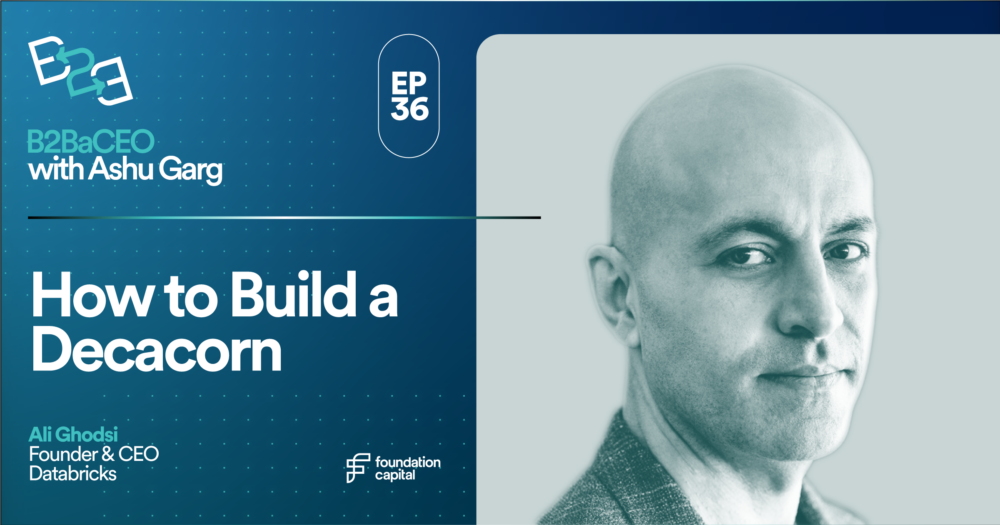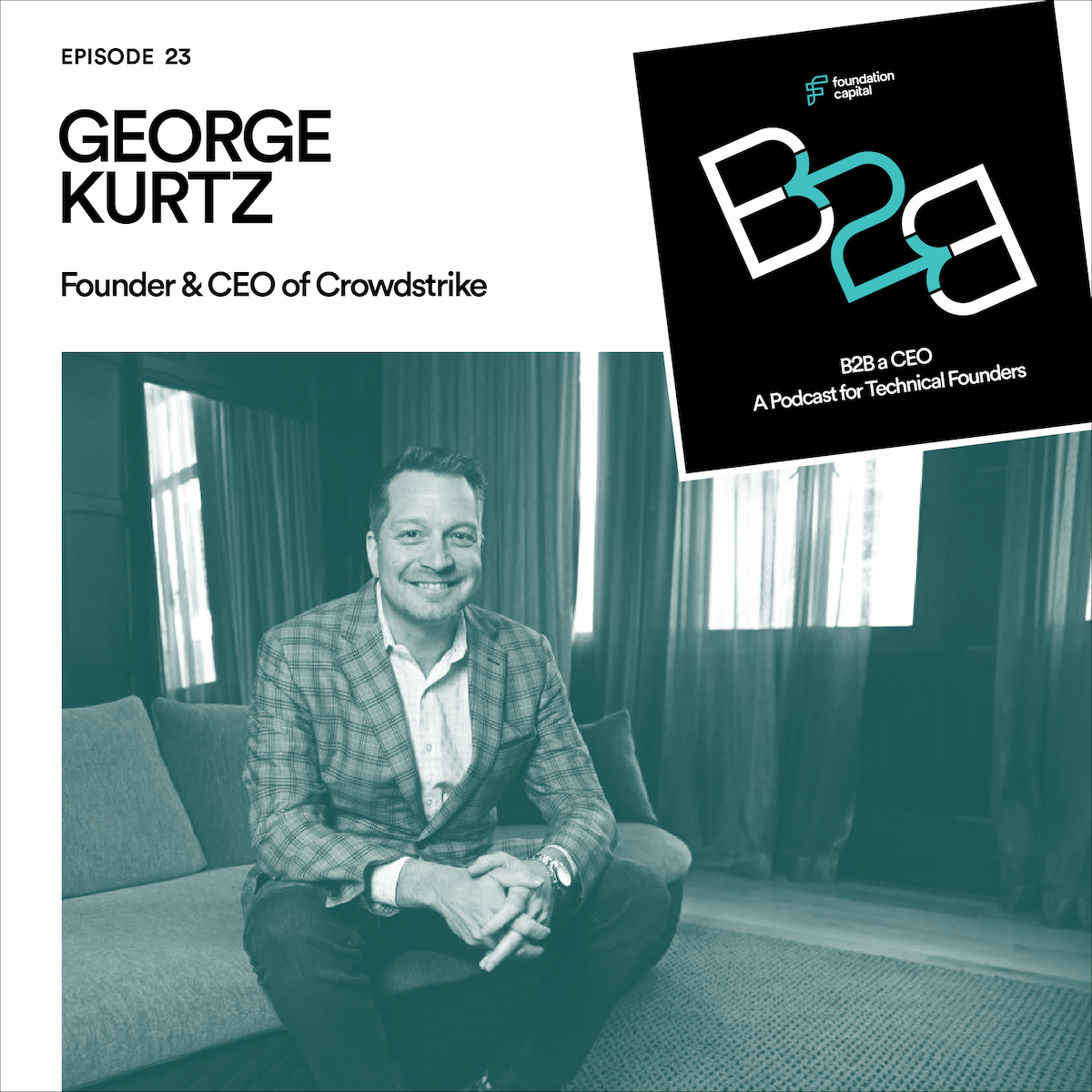Episode 22
How to Go to Market
With Ali Ghodsi, Co-Founder & CEO of Databricks
By Ashu Garg
06.12.2020

On this episode, we have Ali Ghodsi, cofounder and CEO of Databricks, a cloud platform for massive scale data engineering and collaborative data science.
For the first third of the podcast, Ali tells us the story of how a research project at the AMP Lab at UC Berkeley grew into Databricks. This will be of particular interest to anyone who wants to know how to commercialize open source.
After that, Ali gives listeners a crash course on how to build an early stage go-to-market machine—from how and who to hire, to how to coordinate sales and marketing, to how to execute. It’s a fantastic bootcamp for startup CEOs.
I. The Recap
Ali Ghodsi is the cofounder and CEO of Databricks, a cloud platform built for large-scale engineering. In this episode, Ali shares the origin of Databricks and how he and his cofounders grew it from an idea in a research lab to the company it is today. Later in the episode, we’ll hear the lessons Ali learned while scaling and his advice on a go-to-market strategy for early stage startups.
Ali Moves to the US
After spending several years in academia in Sweden, Ali made the leap to come to the US in 2009. As he puts it, it was the “heyday of the AMP lab at UC Berkeley,” and he had the opportunity to work with Ion Stoica (another Databricks cofounder). After his year was up, he committed to another year, and another, and another. Ali and Ion worked in research together during a really exciting time for computer science. Researchers in neighboring labs at Berkeley were hitting “Moore’s Wall” and, as a result, were pushed into researching data centers and new models for computers.
Databricks Gets It’s Start
Ali, Ion, and their cofounders were building an open source project at UCBerkeley. They tried their best to pitch big companies on using their technology, but no one bit. By 2013, they decided to start their own company. Ali was highly reluctant to dive in head first as a cofounder, because he was really enjoying his time at UC Berkeley, but he agreed to be a part of what they were building. As the project grew, Ali noticed that more and more of the team at Berkeley started migrating over to Databricks. Eventually, Ali did the same.
What Caused the Mass Adoption of Databricks?
After six years of rejection, Databricks finally garnered long-deserved attention in 2015. As Ali describes it, this happened overnight. So, what happened? Reynold Xin, another Databricks cofounder, decided that the team would participate in a sorting contest where they were meant to sort 100 terabytes of data as fast as possible. The team spent numerous cycles trying to accomplish their goal and ended up coming in first place. When the results were published, the media ate the story up and things started changing for the team.
Classic Innovator’s Dilemma
You have great tech, but you need to think what a great company will look like 10 years from now. It’s unlikely that what you’re currently working on will get you to materialize your vision. Instead, you should be asking yourself “How can we commoditize what we are working on today?” It’s possible that the new product morphs into something that’s damaging to your existing product. But, that’s the risk you will take for greatness.
What are Some of the Challenges You Had to Overcome?
Ali thinks the biggest struggle for technical founders is tackling the go-to-market strategy. Big enterprises have the advantage of massive channels and sales people to promote new products. But building that muscle from scratch is difficult. If you come from a technical background, you have a deep appreciation for the technology, but that’s not always going to help you sell it. Your GTM team will be full of salespeople. So, the challenge is getting this team to understand your product in a way that allows them to sell it quickly.
Hire the Pros
Ali learned how to hire a go-to-market team the hard way. His overall advice? Hire the pros. Hire people that have experience and tenure working in the areas you need them to. And cohesion is key! A strong GTM team that works well together is invaluable for startups. These are the people who will scale with you.
He outlines the order in which you should hire your team below:
- First, hire salespeople and a sales leader — This will allow you to see which sales pitches are working and resonating with your customers.
- Second, hire a marketing leader — Working with your sales leader to hire a marketing lead will allow them to work together to create messaging that works for both departments.
- Third, hire a strong CFO or head of finance — If your sales leader is driving revenue in the way they should, they’ll be using all tools at their disposal. To balance this cost, you’ll need someone keeping track of funds in and funds out.
- Fourth, hire an HR leader — Many founders don’t make this a priority and end up spending a lot of their time on HR needs. Ali recommends finding someone who can help you build out processes for onboarding, compensation, training, and recruiting.
Be Prepared to Pivot Your Vision
The founders of Databricks had a vision for how their customer base would pay them with the swipe of a credit card. Originally, they deemed a sales team useless. But, as Ali put it, you don’t get to choose how customers use your product. Databricks provides machine learning for massive data sets, allowing customers to potentially improve metrics by about 1%. The only customer base that made sense for their business model are large-scale enterprises. But enterprises don’t just swipe a credit card to pay for your service. Once the Databricks team realized this, they understood that they had to pivot their sales process. Ultimately, it paid off. In just one year, they went from $1M in revenue to $13M in revenue.
Advice for Founders
It’s hard to convince people of the benefits of revolutionary projects. If you use existing trends and products as an example, it’s easier for people to envision. This is why Ali recommends the adoption of an open source project. Improving on an existing model helps market your product. It’s easier to ride an existing wave than to create your own. If you can pick up an open source technology that already has product/market fit, you can avoid many years of R&D to figure those kinks out.
There is no recipe for becoming a CEO, but this list below is as close to a recipe as you’ll get:
- Vision — Formulate the vision that inspires your team, but also your customers.
- Strategy — Decide how you will implement your vision. A broad understanding of your goals will not get you where you want to be. Create a plan.
- Team — Assemble the team that believes in your vision and wants to help you achieve your goal.
- Execute — Decide what you need to to inspire your team in a way that helps make this vision a reality.
Published on 02.17.2022
Written by Ashu Garg


